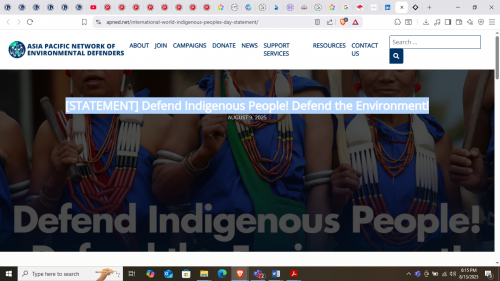
The United Nations Development Programme has approximated that around 70% of the world population of indigenous peoples are in the Asia-Pacific region, making the plight of indigenous peoples one of the pillars of the struggle of environmental defenders in the Asia-Pacific.
While international instruments like the UN Declaration on the Rights of Indigenous Peoples (UNDRIP) have long been promulgated and counterpart protections have been pushed in many countries, we have seen its limitations. It has consistently failed at protecting indigenous peoples from land grabbing. According to the Rights and Resources Initiative in 2015, 18 percent of land is formally recognized as either owned by or designated for Indigenous Peoples and local communities. If put into the context of expert claims and studies that around 50-65% of the world’s land is occupied by indigenous peoples, it leaves around 64 – 72% of indigenous peoples globally without any protection to their right to land.
https://apned.net/international-world-indigenous-peoples-day-statement/
As the global economic crisis deepens, it has pushed corporations to increase the extraction of resources to maintain their profit margins. With no or poor protection mechanisms in place, the ancestral lands of indigenous peoples, which are commonly rich in forest and mineral resources that serve as the raw materials for different industries, are vulnerable to plunder and destruction.
This economic crisis has also pushed political tensions between powerful countries and goaded military actions at different scales, from joint military exercises, construction of new military bases and ports, and, at the worst, the outbreak of war itself. As we have seen in current active warzones, vulnerable groups suffer the most, while local ruling elites benefit the most, profiting from collaboration with the military industrial complex.
When indigenous peoples choose to resist development aggression, destructive resource extraction, and militarization, they find themselves staring down the barrel of state-sponsored harassment, criminalization, enforced disappearances, and killings. The state of indigenous peoples’ rights remains dire, as evidenced by the most recent report of the United Nations Special Rapporteur on Indigenous Peoples:
Indigenous peoples in Asian countries continue to face discrimination and marginalization. Human rights violations stem from the lack of effective protection in domestic laws and policies regarding indigenous peoples’ rights over their traditional territories, lands and natural resources, as well as the failure to respect their rights to participate and to be consulted, in good faith, in decisions affecting them and to obtain their free, prior and informed consent. Land-grabbing and activities linked to large-scale development projects (including the construction of hydroelectric dams), extractive industries, monocrop plantations, and logging are increasing in the region, which in turn results in the massive displacement of indigenous peoples, the destruction of their environment, and rising poverty.
Indigenous peoples are pillars of our community of environmental defenders. They are uniquely situated in the sense that their economic, cultural, and political interests all align with the protection and conservation of the environment. They serve as the forefront of our efforts to reach true sustainable development. We must not let them be left behind in a world that seeks to remove them from their ancestral lands, deprive them of their culture and livelihood, and desecrate their human rights.
Stand with Indigenous Peoples! Resist environmental plunder and militarism!









